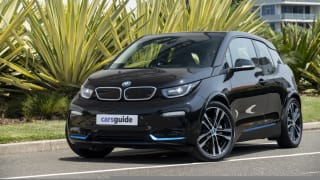
BMW i3s 2020 review
Electric cars have come a long way in the last six years, and that's how long BMW's i3 EV city car has been with us. Does the sporty i3s version retain the spark required to mix it with the latest and greatest?
Browse over 9,000 car reviews

Of all the hundreds of models available on the Australian market, we reckon the Mini Cooper hatch might be best suited as an all-electric car.
After all, it’s premium, peppy and on the pricier end of the light-car spectrum, meaning the pivot to an emissions-free version should be less of a shock compared to more mainstream fare.
Here to put that theory to the test is the Mini Cooper SE, the brand’s first mass-market all-electric model offered in Australia.
Promising the brand’s signature go-kart-like dynamics and a driving range suited to inner-city commuting, can the Mini Hatch Cooper SE appeal where other EVs look lacklustre?
| Mini 3D Hatch 2020: Cooper SE Electric First Edtn | |
|---|---|
| Safety rating | |
| Engine Type | — |
| Fuel Type | Electric |
| Fuel Efficiency | —L/100km |
| Seating | 4 seats |
| Price from | $44,770 |
Priced at $54,800 before on-road costs, the Cooper SE sits atop the Mini three-door Hatch line-up and is even more expensive than the $50,400 performance-orientated JCW.
However, amongst its electric vehicle peers, including the Nissan Leaf ($49,990), Hyundai Ioniq Electric ($48,970) and Renault Zoe ($49,490), a circa-$5000 premium is a bit easier to swallow for a style-focussed European city hatchback.
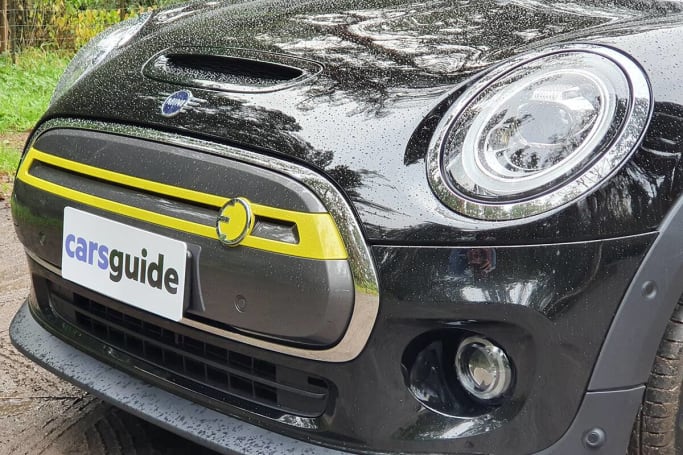
For the money, Mini includes 17-inch wheels, adaptive and automatic LED headlights, rain-sensing wipers, electronically adjustable and heated side mirrors, multi-function leather steering wheel, heated front sports seats, leather interior, carbon-fibre dashboard accents, dual-zone climate control, and keyless entry and start.
An 8.8-inch multimedia screen sits in the centre stack, and comes with features such as satellite navigation with real-time traffic updates, 12-speaker Harman Kardon sound system, voice recognition, wireless smartphone charger, digital radio and wireless Apple CarPlay support (but no Android Auto).

One of the big differences with the Cooper SE though, is the all-digital instrumentation, which shows off how much juice is left in the tank and the how hard the electric motor is pushing.
Driving range, speed, temperature and traffic sign information is also front and centre for the driver, while a head-up display also shows other information such as route guidance.
Like most EVs available on the market today, the high price is justified with the electric drivetrain rather than anything standout on the spec list.
Let’s not beat around the bush, the modern Mini has always been about style, and the all-electric Cooper SE is certainly no exception.

Four no-cost exterior designs are actually available, divided equally between ‘Future’ and ‘Classic’ styles.
In the former category, 17-inch EV-specific ‘Power Spoke’ wheels are fitted, along with yellow-accented mirror caps and front grille for a design that stands out from the crowd.
Our test car came fitted with the ‘Future 2’ pack, which is finished in black metallic paint, but the ‘Future 1’ version scores a ‘White Silver Metallic’ exterior with contrasting black roof.
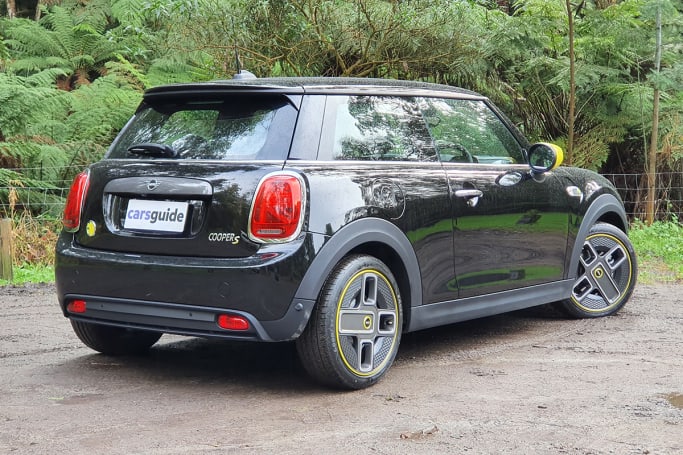
Sure, this version of the Cooper SE looks a little more futuristic, as its name implies, but the two ‘Classic’ options adhere much closer to the look of an internal-combustion Mini.
Wheels still measure 17 inches, but look much more conventional thanks to their dual 10-spoke design, while mirror caps are finished in white, and paint options are either a classic ‘British Racing Green’ or ‘Chilli Red’.
The Cooper SE even comes with a bonnet scoop to mirror its Cooper S counterpart, but keen-eyed car spotters should be able to pick out the unique badging and closed off front grille of the former.
Step inside the Cooper SE and you could nearly confuse it for any other Mini Hatch.
The same interior layout features, including the familiar dashboard layout centred on a large light-up ring.
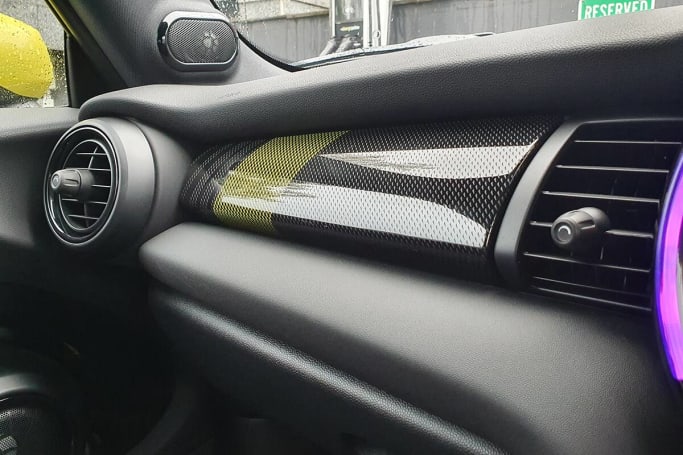
Embedded in the circle is the 8.8-inch multimedia screen, while below is the switchgear for climate controls, drive-mode select and the ignition switch.
Differences in the Cooper SE? A unique yellow-accented dashboard insert is fitted, while the seats are swathed in leather and Alcantara with a cross-stitch design, as well as the aforementioned digital instrumentation.
We actually think it’s a good thing that the Cooper SE looks largely identical to the rest of the three-door Hatch range, and appreciate that this is not one EV that cribs its looks from far-out sci-fi imagery.
Measuring 3845mm long, 1727mm wide and 1432mm tall the Cooper SE is actually slightly shorter and higher than its Cooper S counterpart.
However, both share the same width and 2495mm wheelbase, meaning interior practicality carries over – both the good and the bad.

We also like that the wireless smartphone charger/holder is situated in the armrest, which keeps it out of the way and leaves room around the cabin for keys and wallets.
However, the front door pockets are small and shallow, rendering them all but useless for anything more than slim and small objects.
The rear seats, as expected of a diminutive three-door light hatchback, are cramped, at best, for our six-foot-tall (182cm) frame.
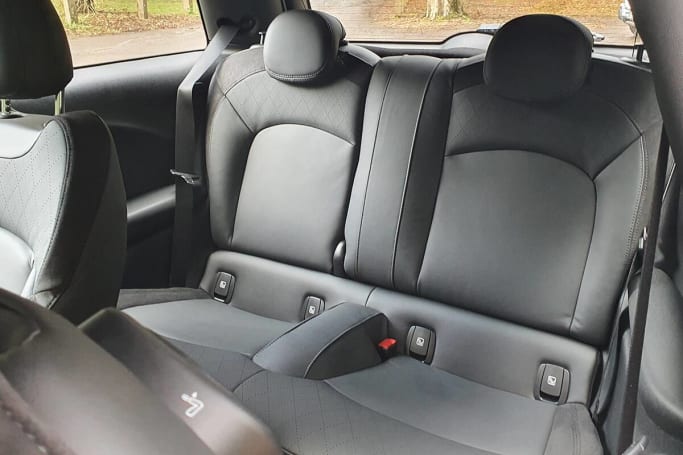
Head- and leg-room is especially lacking, but shoulder-room is surprisingly comfortable. We’d recommend only children for the second row, or those friends you might not get along with.
The boot will swallow 211 litres with the seats up, and expand to 731L with the second-row folded down, which actually matches the Cooper S for rear-end volume.
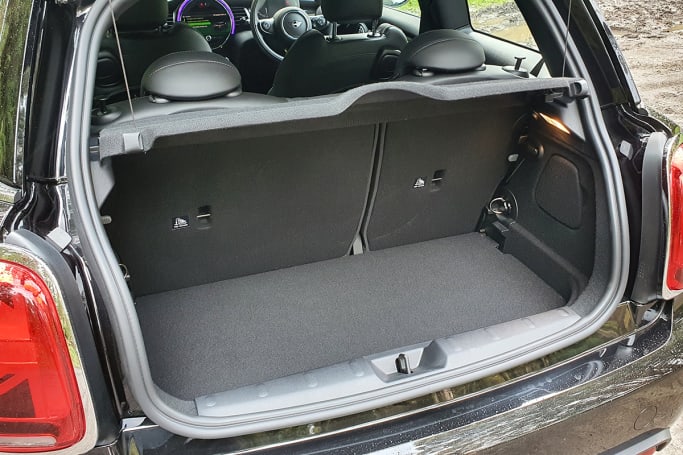
Charging paraphernalia is kept in a compartment under the boot floor (there's no spare tyre as it has run-flats), while luggage tie-down points also feature, but we didn’t spot any bag hooks.
It’s nice that going the electric option doesn’t hamper boot space, but the Mini Hatch was never the most practical city hatch on offer in the first place.
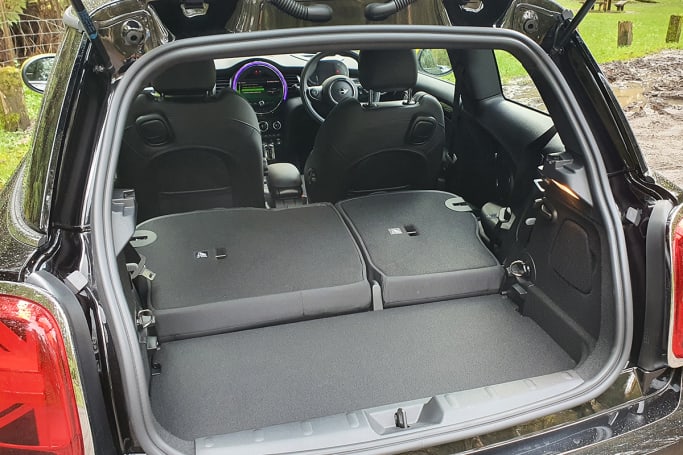
Those that need to regular transport more than one passenger, or large items, might have to look elsewhere.
Powering the Mini Hatch Cooper SE is an electric motor outputting 135kW/270Nm to the front wheels via a single-speed automatic transmission.
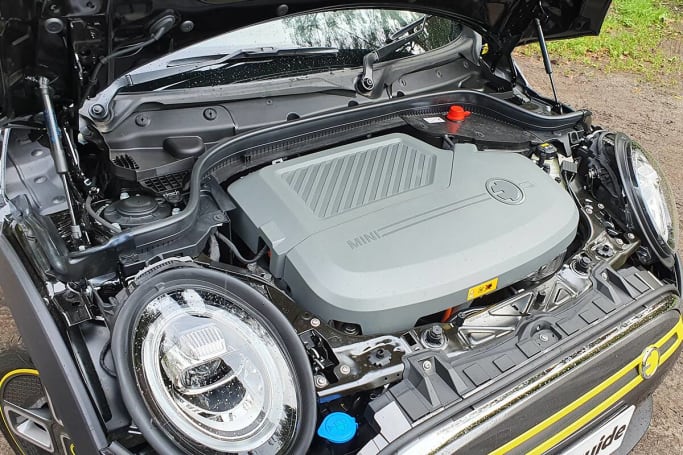
As a result, the all-electric Mini will accelerate from zero to 100km/h in just 7.3 seconds.
This places the Cooper SE between the base Cooper and Cooper S for off-the-line performance, despite its 150-200kg penalty.
The 32.6kWh battery is good for around 233km of driving range according to Mini, though our car showed 154km of range on a 96 per cent battery on a cold Melbourne winter’s morning.
Official consumption figures for the Cooper SE are 14.8-16.8kWh per 100km, however, we managed a lower 14.4kWh/100km in our morning with the car.

Our driving consisted largely of country backroads, inner-city suburbs and a blast down the freeway, with the former two settings offering plenty of opportunity for the regenerative braking to recoup energy.
The Cooper SE is also fitted with a CCS Combo 2 plug that also allows for Type 2 connections.
Plugged in at home, the Cooper SE is said to take about eight hours from 0-100 per cent, however a 22kW charger should cut the time down to around 3.5 hours.
Mini has long aimed to deliver go-kart-like handling in all its cars, and especially so for the smallest Hatch model.
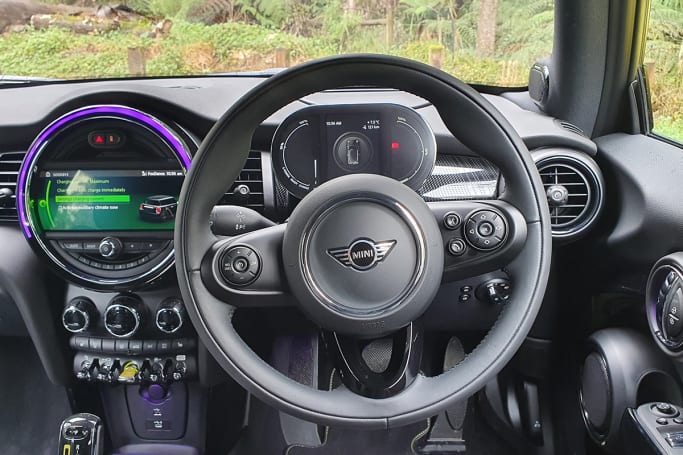
While petrol-powered versions fit that mantra to a tee, does an electric motor and heavy battery upset that characteristic?
For the most part, no.
The Mini Hatch Cooper SE is still super-fun to throw into a corner, and the levels of grip on offer inspire confidence even on wet roads.
A large part of this is down to the rubber, with Mini opting for Goodyear Eagle F1 tyres measuring 205/45 at each corner instead of the usual low-rolling resistance, super-skinny tyres that come on other EVs.
Even with all the torque available right off the line, and piloting the Mini through some twisty country roads on a wet Melbourne morning, the Mini Cooper SE retained its sure-footedness and composure despite our best efforts.
To accommodate the heft of the battery (and to protect the underbody from damage), the ride height in the Cooper SE is actually increased by 15mm.
However, the all-electric Hatch actually has a lower centre of gravity thanks to the beefy battery pack.
There is no escaping the extra weight though, with the Cooper SE taking a touch longer to settle after a bump and being a tad slower to change direction.
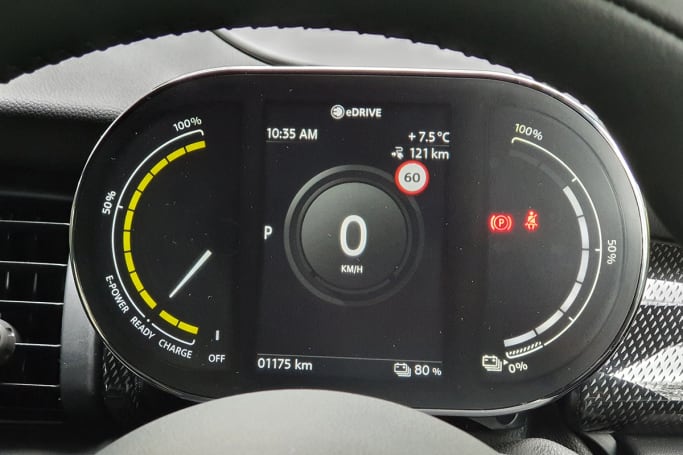
The electric motor also means a brisk, though not exactly quick, 0-100km/h acceleration time, but it’s the 0-60km/h time of 3.9s that is especially useful for such a small city hatchback.
Though the Cooper SE comes with four different drive modes - Sport, Mid, Green and Green+ that adjust steering and throttle response - the two regenerative braking settings will actually alter the characteristic of the car more.
The two settings available – low- and high-energy recovery mode – adjust the aggressiveness of energy recuperation from the brakes.
In low mode, the Cooper SE behaves much like a standard car, with the brake pedal needing to be applied to slow, while the high-energy recovery mode will aggressively retard speed once you lift off the throttle.
However, even the high setting won’t bring the car to a complete stop like Nissan’s e-pedal function in the Leaf.
On our way down Mount Dandenong, we actually managed to recoup about 15km worth of energy using the high-energy recovery mode, which did a lot to alleviate some range anxiety.
The Green and Green+ modes will also add few extra kilometres of range if you are worried you won’t make it to a charger, but a stand out feature for us was that the use of air conditioning had no effect on range.
Even with the fans turned to max and the temperature set to ice cold, we didn’t see any drop in the estimated driving range at all.
All in all, Mini has delivered an ultimately rewarding and fun driving experience for drivers of the Cooper SE, certainly more engaging than some of the other mainstream alternatives, and possibly the best steering EV south of the Porsche Taycan.
Basic Warranty
3 years / unlimited km warranty
ANCAP Safety Rating

The Mini Hatch Cooper SE has not been crash tested by ANCAP or Euro NCAP, though the rest of the three-door line-up carries a four-star rating from 2014 testing.
However, such a rating is not easily applicable to the Cooper SE due to differences in weight, battery placement, electric motors and engine placement.
As standard, the Cooper SE is fitted with a bevy of safety equipment including adaptive cruise control, City Crash Mitigation (CCM) - also known as autonomous emergency braking (AEB) - with pedestrian detection, forward collision warning, front and rear parking sensors, self-parking functionality, reversing camera, and traffic sign recognition.
Dual ISOFIX child seat mounts and top tethers are also found in the rear, while six airbags are fitted throughout.
Like all new Minis, the Hatch Cooper SE comes with a three-year/unlimited kilometre warranty, which also comes with roadside assist and 12 months of anti-corrosion assurance.
Battery warranties are often longer than vehicle warranties, and the Cooper SE's battery assurance period is set at eight years.
Service intervals were not available at the time of writing, however, Mini offers a five-year/80,000km ‘Basic Cover’ plan starting at $800 for the Cooper SE, while the ‘Plus Cover’ plan is priced from $3246.
The former covers an annual vehicle check-up and replacement of the microfilter, air filter and brake fluid, while the latter adds renewal of front and rear brakes, and wiper blades.
Mini’s Hatch Cooper SE might not be a revolutionary EV like the Tesla Model S or even first-generation Nissan Leaf, but it certainly delivers on the brand’s trademark fun factor.
Sure, some will be turned off by the sub-200km real-word driving range, less-than-average practicality and high price tag, however, chic styling seldom comes without a trade-off.
| Vehicle | Specs | Price* | |
|---|---|---|---|
| Cooper 60 Years Edition | 1.5L, PULP, 6 SP MAN | $27,610 – 33,220 | 2020 Mini 3D Hatch 2020 Cooper 60 Years Edition Pricing and Specs |
| John Cooper Works | 2.0L, PULP, 8 SP | No recent listings | 2020 Mini 3D Hatch 2020 John Cooper Works Pricing and Specs |
| Cooper S 60 Years Edition | 2.0L, PULP, 7 SP | $39,160 – 46,090 | 2020 Mini 3D Hatch 2020 Cooper S 60 Years Edition Pricing and Specs |
| Cooper | 1.5L, PULP, 7 SP AUTO | No recent listings | 2020 Mini 3D Hatch 2020 Cooper Pricing and Specs |
| Price and features | 7 |
|---|---|
| Design | 9 |
| Practicality | 6 |
| Under the bonnet | 7 |
| Efficiency | 10 |
| Driving | 8 |
| Safety | 8 |
| Ownership | 7 |
$25,888
Lowest price, based on 10 car listings in the last 6 months